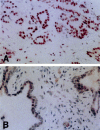Increased expression of the interleukin-11 receptor and evidence of STAT3 activation in prostate carcinoma
- PMID: 11141475
- PMCID: PMC1850253
- DOI: 10.1016/S0002-9440(10)63940-5
Increased expression of the interleukin-11 receptor and evidence of STAT3 activation in prostate carcinoma
Abstract
Previous investigations have shown that interleukin-6, a member of the JAK-STAT activating family of cytokines, plays an important role in prostate carcinoma. Here we demonstrate the co-expression of another member of this cytokine family, interleukin-11 (IL-11), and components of its receptor (interleukin-11 receptor; IL-11R), ie, IL-11Ralpha (involved in ligand recognition), and gp130 (involved in signal transduction) in cultured normal and malignant prostate-derived epithelial cell lines. In the DU-145 prostate carcinoma cell line, rhIL-11 stimulates a transient and dose-dependent increase in the tyrosine 705-phosphorylated, active form of STAT3 (STAT3 P-Tyr705), involved in the downstream signaling of IL-11R and other members of the gp130-dependent receptors. The ability of IL-11 to activate STAT3 in prostate-derived cells may be mechanistically important, given recent data suggesting that constitutively activated STAT3 may be associated with the malignant phenotype. In 51 human primary tissues derived from normal prostate, benign prostatic hyperplasia, and prostate carcinomas, IL-11Ralpha and gp130 were commonly expressed, with a statistically significant elevation in the expression of IL-11Ralpha in prostate carcinoma. Also, the tyrosine-phosphorylated, activated form of STAT3 was observed more prominently in the nuclei of cells residing in malignant glands compared to those in nonmalignant samples. Thus, the IL-11 receptor system is up-regulated in prostate carcinoma, and may be one part of a cytokine network that maintains STAT3 in its activated form in these tissues.
Figures



References
-
- Landis SH, Murray T, Bolden S, Wingo PA: Cancer statistics, 1999. CA Cancer J Clin 1999, 49:8-13 - PubMed
-
- Du XX, Williams DA: Interleukin-11: review of molecular, cell biology and clinical use. Blood 1997, 89:3897-3908 - PubMed
-
- Keller DC, Du XX, Srour EF, Hoffman R, Williams DA: Interleukin-11 inhibits adipogenesis and stimulates myelopoiesis in human long-term marrow cultures. Blood 1993, 82:1428-1435 - PubMed
Publication types
MeSH terms
Substances
LinkOut - more resources
Full Text Sources
Other Literature Sources
Medical
Molecular Biology Databases
Miscellaneous

